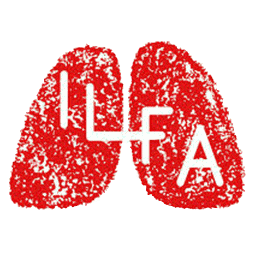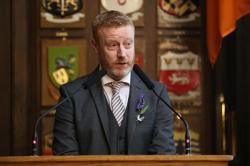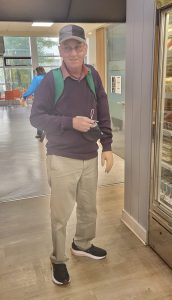Share Your Story

Share Your Story

If you would like to share your story and experience of lung fibrosis, we would love to hear from you.
We always need people to share their personal story of being diagnosed with lung fibrosis and how they have adapted to living well with the condition.
From time to time, media opportunities arise and ILFA asks people to share their lung fibrosis story to highlight the importance of this life-changing condition among the public. Such stories are hugely valuable as they help raise awareness of lung fibrosis. Contact ILFA on 086 057 0310 or email gemma@ilfa.ie if you would like to help.
Please read the personal stories from ILFA members on the left hand side of the page.
 Enjoy Life!
Enjoy Life!
Patient, advocate and fundraiser Pam Martin shares some tips on coping with an IPF diagnosis, staying positive and enjoying life to the max.
I would personally like to thank ILFA, for the work they do for patients and families who have been hit with a diagnosis of lung fibrosis. It’s a blow when you have been given the news that you have a serious lung condition, but ILFA has been with me every step of the way with help, support, and a great support group that provides a wealth of information shared by patients and carers alike. So for this, I thank all those involved with this wonderful organisation.
I would like to share with you some information about myself as a patient living with Idiopathic Pulmonary Fibrosis (IPF). I was diagnosed in December 2009. I considered myself quite fit and was easily able to swim 100 lengths of a standard pool, in one hour. After, I changed gym to a 33 meter pool, I was swimming at least 50 lengths but within 3 months my breathing was not quite right. I also developed a cough and made the excuse that it was probably due to the new swimming pool and maybe the chlorine. When I went on holiday to the Canaries, I could not walk without stopping and coughing, and again I came up with another excuse to explain my symptoms.
I worked in a medical centre and the GP was concerned about me. After 3 lots of antibiotics, I was getting worse and the GP referred me to the Accident and Emergency Department. I was admitted to hospital for 7 weeks and a biopsy confirmed IPF. So within 3 months of being fit to being told that I may need a lung transplant at 51 years of age, having never smoked, was a hell of a shock to me, my family and friends. After a battle with getting the correct medication and pure determination on my part, I started feeling better. I joined a Pulmonary Rehabilitation class which I would recommend to all patients, I know it’s hard and sometimes you can’t breathe but please fight it as you will feel the benefit.
What I really need to get across is that it’s not the end – you can still enjoy life, I still have my foreign holidays, I need oxygen on the plane but airlines are pretty good and take good care of you. I use my portable Inogen machine and there are other options available, so please ask your supplier – they will be happy to help you. Aer Lingus and Ryanair allow you to travel with oxygen equipment, just look up the special assistance departments when booking. Both airlines have a form that has to be signed by your GP – usually within two weeks of your travel date. Even cruise ships allow the equipment and your oxygen provider will supply you with a list of companies that will provide you with your specific needs. I cruised from Spain and the oxygen was in my cabin on arrival. You will need to state this when booking, but really it’s quite easy so don’t be afraid to ask.
Don’t be embarrassed about using oxygen, and don’t confine yourself to home – get out and enjoy life! Just give yourself that little push to get up and get out. Explain to people that you can’t tolerate smoke or heavy perfumes (be honest!), or whatever it is that sets off your cough.
I would like send thanks to all the fundraisers who help ILFA with much needed funds to enable them continue the good work they do. To Irishkop and YNWA Irish Reds, and Rafa Benitez, for supporting me and ILFA through fundraising – a big ‘THANK YOU!’
Thank you to the ILFA committee and the people who attend the support group – we have had laughs and tears and you all hold a very special place in my heart!
Best wishes,
Pam Martin
IPF patient, patient advocate and fundraiser
[Pictured are Pamela Martin, Rafa Benitz, Eddie Cassidy, Stephen Cassidy]
 The Greatness Within
The Greatness Within
Transplant recipient David Crosby celebrates his new lease of life and channels the ‘greatness within’ as he prepares for the New York City Marathon
When I was diagnosed with IPF in late 2015, I was devastated. Having lost three siblings to a lung disease in childhood, one of whom was on a heart and lung transplant list, I thought my days were numbered. But being put under the excellent care of the respiratory team at the Mater Hospital gave me the hope and confidence that this was not to be.
With the support of medical staff, family, friends and patient support groups (ILFA), I was able to find the strength to do my utmost to get up and fight every day. From taking medication, oxygen 24 hours a day and taking on every bit of advice I was given, I was able to live my life as positively as possible.
Shortly after I was given my diagnosis, my doctor discussed lung transplantation as the best option for me, as my IPF was progressing rapidly. I was a 40 year old Dad to three small children, a husband, and I was afraid for their future and my own. Everything that was asked of me I did with enthusiasm. I exercised daily, lowered my BMI (I lost 2.5 stone in 8 weeks), attended every appointment and kept a positive attitude as much as possible. I was on the transplant list a short time when I received my double lung transplant.
It is such an overwhelming experience of many emotions. Fear of the unknown, afraid of the outcome, and then afterwards relief and elation, and a sense of gratitude to medical staff, but mostly bittersweet, when you think of your Donor and their family. I think of them every day, when I can breathe easily, walk freely with no oxygen tubes, play with my children and see a brighter future for myself, my wife and family. Without my Donor’s wonderful gift of life and the amazing talented medical staff, I would not have had a second chance of life.
My outlook on life has totally changed. I am seizing every opportunity and trying to give back to the many people who have helped and supported me along the way.
I have set myself a challenge of completing the New York City Marathon in November 2017 in honour and memory of my Donor, while raising funds for charity. I was honoured to speak at the launch of Organ Donation Awareness week in March 2017. I was also given opportunities to speak of my experiences in public, at schools, in newspapers, TV shows and on radio.
I am now looking forward in life knowing that … “FAILURE IS NOT AN OPTION“.
And that we all have … “GREATNESS WITHIN”
David Crosby
Lung transplant recipient and fundraiser
Creating Positivity
Two years on from her own IPF diagnosis, support group leader and fundraiser Noreen O’Carroll advocates staying informed, staying in control and availing of back-up services.
In June 2015, I was diagnosed with IPF. A few months later, I attended an ILFA Information Day in Dublin. It was really useful to get good information from healthcare professionals but I left still never having spoken to another person with this disease. That day, a lady accidentally bumped her oxygen container against my chair. At that point, I was close to tears thinking “is this what’s ahead of me? how am I going to cope?” My sister who knows me too well, nudged me in the ribs and whispered “come back, you’ve gone too far”. Those words were a gift. When I have a bad day, I remember those words and remind myself to stay with just today. There is no point in worrying about the future, I’m not there yet, so I can’t do anything about it, but today I can try to have the best day I can by creating positivity in my life. This helps me cope with the negative thoughts that have a way of creeping in.
So two years into my diagnosis what has helped me? Three things stand out for me; (1) Being informed (2) Being in control and (3) Support
Thanks to the Internet, it’s easy to be informed. When I was diagnosed it was difficult to read the hard facts of this disease. I also realised I needed to know more, so it was useful to find reliable websites with good practical information. I found the ILFA website had good resources and information that’s given in a positive way. I was able to recommend it to my family too when I didn’t have the energy or words to explain what this disease is about.
Informing myself about IPF helped me to feel more in control and take responsibility for my health with the support of healthcare staff. I now know how important exercise and diet are, I know my test results and what they mean for my health. I know if I reach a certain point, I will need oxygen and I’m ok with that now because I know I won’t be putting my other organs under stress. I know the questions I need to ask my consultant when I meet him and if I don’t understand something to ask him to explain it again. I was also able to request an early referral to the transplant clinic at the Mater Hospital.
With regards to support; “No man is an island”. If we allow ourselves to be supported by those around us, it is definitely an enriching experience. It took me a long time to be able to tell people about my diagnosis, maybe because I didn’t want pity or to be seen in a different light because I am still me and that’s something I had to work through. To help me do that, it was invaluable to see a therapist for a couple of weeks and work through all the emotional stuff this diagnosis brought up. It helped me make sense of it all and figure out how I could normalise my life again. I go back for a session or two whenever I begin to feel overwhelmed, but this has become less and less. At least I know that resource is there for me if I need it. Within the primary care service, you can access six free counselling sessions. Your GP can refer you, you just need to ask.
I also discovered that there are IPF specialist centres. My consultant referred me and now that I am linked in with the respiratory clinic, I can access pulmonary rehabilitation and I meet the respiratory nurse on a regular basis. She monitors my medication and is an amazing source of support. I know if I have any concerns, I can call her.
This disease is isolating and the chances knowing somebody with it is slim but it was really important for me to connect with others. In January 2017, I started the Midwest IPF support group. Support groups aren’t for everybody but I can honestly say I really enjoy meeting the men in our group and we learn from each other. One member has had a lung transplant and this makes me feel positive and hopeful for my future.
Last October, the Limerick Ladies Mini-marathon took place and I decided to fundraise for ILFA. Anyone who knows me, knows that I am allergic to walking (I’m so lazy) so this was a big deal for me. I was asking people to support me so I had to tell them why I was doing this. Before I knew it, my family decided they were doing the mini-marathon too, even my 83 year old mother was getting in on the act, I had to call that one and tell her she was the official tea lady on the day. My son Steven was renamed ‘Stephanie’ and was given a wig to wear. That day showed me that I don’t have to do this on my own – my husband, children and family are my biggest source of support. They will always be there for me and for that I am grateful every single day.
I read an article online where the author talked about the importance of having something positive to look forward to, however big or small, it’s a chance to reclaim some control over life. I really believe the value of this because initially when you have been diagnosed, you are in shock. With time you will realise, that you do have a future and having something to look forward to and making plans are what keeps us going.
So this year I am planning to learn how to build dry stone walls – completely random, I know! I plan to buy a poly-tunnel and grow fruit and veggies, and go to Indonesia to help my daughter realise her dream of setting up yoga retreat courses, I might be her best customer yet. These plans will keep me moving forward and positive about my life despite IPF – and when you’re ready you will find what works for you.
Noreen O’Carroll
IPF Patient, support group leader and fundraiser
My Transplant
Transplant recipient Robert Cooke shares his experience as an IPF patient and gives thanks for his second chance.
It all began with a tickly cough that wouldn’t go away. After a couple of months, I went to my GP and was referred to a respiratory consultant who carried out tests which seemed to point to asthma. Six months later, I experienced chest pain and tightness across my shoulders when walking, so my GP sent me for a heart stress test and chest x-rays. Pulmonary fibrosis was mentioned for the first time. I was immediately referred to another respiratory physician and diagnosed with Idiopathi Pulmonary Fibrosis. It was a huge shock to learn that it was a progressive illness and the only cure was a lung transplant.
I was immediately prescribed oxygen, initially for 8 hours a day or during physical activity, but then I needed it more and more. Six months later, I was started on Pirfenidone, a drug that can slow down the progress of the disease. After six months, my lung function was still deteriorating, probably less so because of the medication, but I was now using oxygen 24 hours a day and was less able to do things or walk more than a few hundred meters.
On a visit to my consultant in 2016, we asked about the possibility of a lung transplant. He agreed that it was the only hope and admitted me for a week of tests. You can only go on the transplant list if all your other organs are healthy so everything had to be thoroughly checked out. Thankfully, apart from two diseased lungs, I was ok. Next, I was assessed by the transplant team at the Mater Hospital. It was during these meetings with the surgeons, transplant nurses, psychiatrist and social worker that the enormity of what a transplant entails began to sink in. You are given a handbook that explains the procedure, the complications that can occur, the follow-up treatment plan, the life-long drug regime, the changes in lifestyle, and the home support needed – but all so worth it, if it means a second chance at life.
Two weeks later, I was on the transplant list and the waiting game for a suitable lung began. I packed my bag, had my mobile phone with me at all times, and waited and hoped. One of the transplant co-ordinators rang me every Tuesday to see how I was doing. This call was a huge comfort and once they even recognised a flare up in my IPF from how my breathing sounded over the phone and told me to go straight to my GP.
After 9 weeks on the list, my mobile phone rang. Within an hour I was on my way to the Mater Hospital by ambulance. My wife and son followed by car because if I wasn’t a match or I wasn’t chosen, they would have to drive me home. We had been warned that this was a very real possibility. I arrived at 11pm and after numerous tests, we were told that my bloods matched and that there was definitely one usable lung and probably a second one but we had an agonising wait because it wasn’t until 1.30pm the next afternoon that I got the go-ahead!
The next thing I remember was waking up in ICU attached to lots of tubes and machines. Over the next four or five days, the number of tubes and attachments was reduced and I managed a wobbly walk around the intensive care unit. Once I was steadier on my feet, I was moved to the Heart and Lung Ward where I continued my road to recovery helped by the fantastic care I got from all the Heart and Lung Team.
I had a slight stroke during my operation and this affected my eye-hand co-ordination and eyesight so I had difficulty sorting out the numerous tablets I had to take twice a day. You can’t go home until you can do this for yourself so this delayed my discharge by a few days. Just three weeks after my transplant, I was allowed home. It was quite nerve-wracking as from now on it was up to us alone to look after this very precious lung.
For the next three months, I couldn’t go into public places without wearing a face mask and had to avoid crowded places. Initially, I had to attend the Mater Hospital clinic every week. The clinic is like a club with people swapping stories and tips but it can be very tiring as some people have to travel long journeys to Dublin for the 3-4 hours it takes to have your bloods taken, pulmonary function tests, and consultations with a transplant nurse and doctor. For the rest of my days, I will have to record my weight, temperature and daily medication in my Transplant Medication Diary so that if a blip occurs, infection can be ruled out as a cause.
Six months after the transplant, my quality of life has improved so much. I can drive again, do the shopping, visit friends, have a meal out, walk on the beach, and I have lived long enough to see my youngest granddaughter take her first steps and call my name – inconceivable this time last year.
This gift of life selflessly given to me and my family by another family at a time of the most enormous tragedy for them is priceless and I will do my best always to honour and care for that gift. As a family, we cannot thank the donor and their family enough for giving us this second chance. They are in our thoughts and prayers every day.
Robert Cooke
Lung transplant recipient
An uplifting story of hope and gratitude from John McMahon, ILFA member
“In March 2020, I developed a cough. I took a couple of cough bottles that didn’t have any effect, and so I continued my life, thinking it would eventually go away.
We have a camper van – I like going to Sligo camping and I always wanted to go up to Queen Maeve’s grave. One Saturday morning, my wife and I decided to go up the hill but less than a quarter of the way up, I started to get breathless. At first, I put this down to a sandwich that I had eaten before setting off but 300 metres on, I just couldn’t breathe. I knew something wasn’t right and my wife said that when we got home, we would make an appointment to see my doctor which I did. I was referred to a respiratory specialist, Dr Aidan O’Brien, in Limerick University Hospital and it was nearly 7-months later when I got to see him and had some tests. Two days before Christmas Eve, he gave me news that I was not expecting! I was told I had hardening and scaring of my lungs; I had pulmonary fibrosis. He said I had a limited time to live unless I was able to get a lung transplant. I was referred to Professor Egan at the Mater Hospital in Dublin whom I met in early 2021. I was told a transplant was the only cure for me, but it takes time to get on list and a lot of tests would have to be done first.
I was put in touch with the Lung Fibrosis Clinic in Ennis where I meet specialist nurses Carmel McEnerney and Paula Ryan, and I was started on anti-fibrotic medicine. Luckily, I didn’t get any side-effects from the medicine. After a year, my breathlessness started to get the better of me so portable oxygen was prescribed, and this really helped.
In 2022, I had to stop going to work as I found myself exhausted and had no energy left. I was called to the Lung Transplant Unit at the Mater Hospital for a series of tests. I had to get an oxygen concentrator to give me enough oxygen to breathe – I felt like a prisoner in my own home and I could only get as far as the back door. My health deteriorated and I was brought to Limerick University Hospital and then transferred to the Mater University Hospital. There I was put on a new oxygen machine which really helped. I was there for over 2-months when one morning in the early hours, I was told there was a potential lung donation. This turned out to be a match for me and the lung transplant went ahead.
I will never forget the feeling of waking up without oxygen to help me breathe – that feeling was fantastic I have been lucky enough to have a second chance at life which I intend to use every day. The importance of organ donation to people like me is literally life-changing. I pray to my donor and their family every night and thank them for taking the difficult decision that day. Ever since, I have excelled in building up my weight from 52kg to my normal weight of 68kg. My walking is up to 5km a day so far and my leg strength is returning.
Many thanks for everything.”
John McMahon
+ Photo (John)
+ photo of hands in heart shape
